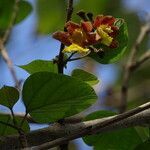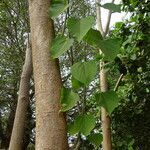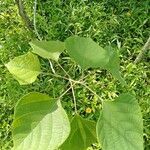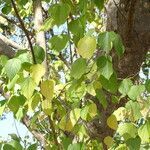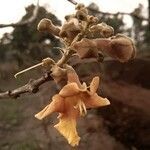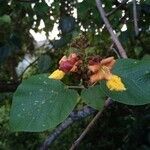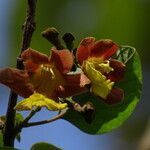| Therapeutic use
|
Antiviral agents (aerial part), Anti-bacterial agents (bark), Antidotes (bark), Anti-inflammatory agents (bark), Antioxidants (bark), Antipyretics (bark), Antirheumatic agents (bark), Antiviral agents (bark), Appetite stimulants (bark), Arthralgia (bark), Asthma (bark), Cough (bark), Dandruff (bark), Demulcents (bark), Dysentery (bark), Dyspepsia (bark), Edema (bark), Facial paralysis (bark), Fatigue (bark), Fever (bark), Fractures, bone (bark), Furunculosis (bark), Hematologic diseases (bark), Hemorrhage (bark), Hemorrhoids (bark), Hypoglycemic agents (bark), Inflammation (bark), Insect bites and stings (bark), Labor pain (bark), Laxatives (bark), Liver diseases (bark), Malaria (bark), Pain (bark), Pharyngitis (bark), General tonic for rejuvenation (bark), Scorpion stings (bark), Stomach diseases (bark), Thirst (bark), Tuberculosis (bark), Vertigo (bark), Antirheumatic agents (flower), Astringents (flower), Bites and stings (flower), Cough (flower), Fatigue (flower), Fever (flower), Furunculosis (flower), Gonorrhea (flower), Hematologic diseases (flower), Hypertension (flower), Leprosy (flower), Skin diseases (flower), Hair loss (fruit), Anemia (fruit), Antioxidants (fruit), Antirheumatic agents (fruit), Aphrodisiacs (fruit), Appetite stimulants (fruit), Arthralgia (fruit), Cathartics (fruit), Constipation (fruit), Cough (fruit), Dandruff (fruit), Demulcents (fruit), Diuretics (fruit), Dysentery (fruit), Dysuria (fruit), Emaciation (fruit), Fever (fruit), Genital diseases, female (fruit), Heart diseases (fruit), Hemorrhage (fruit), Laxatives (fruit), Leprosy (fruit), Leukorrhea (fruit), Liver diseases (fruit), Lung diseases (fruit), Metabolism (fruit), General tonic for rejuvenation (fruit), Skin diseases (fruit), Thirst (fruit), Ulcer (fruit), Urination disorders (fruit), Urologic diseases (fruit), Urticaria (fruit), Vaginal diseases (fruit), Vaginitis (fruit), Vomiting (fruit), Wounds and injuries (fruit), Cooling effect on body (fruit), Anthelmintics (leaf), Antidotes (leaf), Anti-inflammatory agents (leaf), Antimutagenic agents (leaf), Antirheumatic agents (leaf), Appetite stimulants (leaf), Arthralgia (leaf), Bites and stings (leaf), Common cold (leaf), Cough (leaf), Demulcents (leaf), Fever (leaf), Flatulence (leaf), Fractures, bone (leaf), Furunculosis (leaf), Gonorrhea (leaf), Headache (leaf), Hematologic diseases (leaf), Hemorrhoids (leaf), Laxatives (leaf), Lice infestations (leaf), Scorpion stings (leaf), Snake bites (leaf), Tuberculosis (leaf), Ulcer (leaf), Wound healing (leaf), Wounds and injuries (leaf), Abdominal pain (root), Immunostimulant (root), Analgesics (root), Angiotensin-converting enzyme inhibitors (root), Anthelmintics (root), Antidotes (root), Antioxidants (root), Antipyretics (root), Antirheumatic agents (root), Appetite stimulants (root), Arthralgia (root), Bites and stings (root), Common cold (root), Constipation (root), Cough (root), Demulcents (root), Digestive system diseases (root), Dyspepsia (root), Emaciation (root), Erectile dysfunction (root), Fatigue (root), Fever (root), Furunculosis (root), Galactogogues (root), Gonorrhea (root), Gout (root), Hallucinations (root), Headache (root), Hematologic diseases (root), Hemorrhage (root), Hemorrhoids (root), Inflammation (root), Insect bites and stings (root), Laxatives (root), Liver diseases (root), Malaria (root), Mouth diseases (root), Pain (root), Premature ejaculation (root), General tonic for rejuvenation (root), Scorpion stings (root), Snake bites (root), Thirst (root), Tuberculosis (root), Ulcer (root), Urination disorders (root), Urologic diseases (root), Vomiting (root), Cooling effect on body (root), Hemagglutination (seed), Epilepsy (shoot), Cachexia (stem), Digestive system diseases (stem), Fever (stem), Hematologic diseases (stem), Hemorrhage (stem), Hypoglycemic agents (stem), Inflammation (stem), Pain (stem), Anti-poisoning (stem), Thirst (stem), Vertigo (stem), Anasarca (unspecified), Anodyne (unspecified), Anthrax (unspecified), Asthma (unspecified), Bilious (unspecified), Bite (unspecified), Bite(Rat) (unspecified), Bite(Snake) (unspecified), Bite(Tiger) (unspecified), Blood (unspecified), Choking (unspecified), Cholera (unspecified), Convulsion (unspecified), Delirium (unspecified), Demulcent (unspecified), Diarrhea (unspecified), Dropsy (unspecified), Dyspepsia (unspecified), Epilepsy (unspecified), Fever (unspecified), Gout (unspecified), Gravel (unspecified), Intoxication (unspecified), Lactogogue (unspecified), Refrigerant (unspecified), Rheumatism (unspecified), Rinderpest (unspecified), Septicemia (unspecified), Smallpox (unspecified), Sore (unspecified), Splenitis (unspecified), Swelling (unspecified), Syphilis (unspecified), Tonic (unspecified), Urticaria (unspecified), Headache (unspecified), Hemorrhage (unspecified), Thigh (unspecified), Throat (unspecified), Colic (unspecified), Madness (unspecified), Phthisis (unspecified), Tumor(Abdomen) (unspecified), Bronchitis (unspecified), Stomachic (unspecified), Alcoholic intoxication (unspecified), Hair loss (unspecified), Anthelmintics (unspecified), Anticonvulsants (unspecified), Antirheumatic agents (unspecified), Aphrodisiacs (unspecified), Appetite stimulants (unspecified), Astringents (unspecified), Brain diseases (unspecified), Cardiotonic agents (unspecified), Cough (unspecified), Demulcents (unspecified), Digestive system diseases (unspecified), Diuretics (unspecified), Dizziness (unspecified), Edema (unspecified), Emaciation (unspecified), Fractures, bone (unspecified), Galactogogues (unspecified), Gonorrhea (unspecified), Heart diseases (unspecified), Hematologic diseases (unspecified), Hemorrhoids (unspecified), Kidney calculi (unspecified), Laxatives (unspecified), Lung diseases (unspecified), Memory disorders (unspecified), Myiasis (unspecified), Nervous system diseases (unspecified), Nootropic agents (unspecified), Obesity (unspecified), Pain (unspecified), Pharyngitis (unspecified), Puerperal disorders (unspecified), Scorpion stings (unspecified), Sepsis (unspecified), Snake bites (unspecified), Splenic diseases (unspecified), Thirst (unspecified), Tongue diseases (unspecified), Tuberculosis (unspecified), Tuberculosis, pulmonary (unspecified), Ulcer (unspecified), Urination disorders (unspecified), Wounds and injuries (unspecified), Lip diseases (unspecified), Rheumatoid arthritis (unspecified), Abdominal pain (whole plant), Appetite stimulants (whole plant), Astringents (whole plant), Fever (whole plant), Hematologic diseases (whole plant), Hemorrhoids (whole plant), Leprosy (whole plant), Pain (whole plant), Scorpion stings (whole plant), Snake bites (whole plant), Ulcer (whole plant)
|
